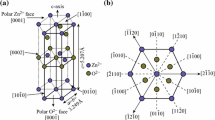Abstract
ZnO nanoparticles (NP) with different morphologies such as nanorods (NR), isotropic NP, and cloud-like (CL) structures have been synthesized by an organometallic route. The prepared ZnO nanostructures have been deposited on miniaturized silicon gas sensor substrates by an inkjet method, and their responses to CO, C3H8, and NH3 gases have been studied at different operating temperatures (340–500 °C) and relative humidity of 50 %. It is noteworthy that the morphology of the nanostructure of the sensitive layer is maintained after thermal treatment. The morphology of ZnO NP significantly influences the sensor response level and their selectivity properties to reducing gases. Among the three different ZnO types, sensors prepared with NR show the highest response to both CO and C3H8. Sensors made of isotropic NP and CL structures show a lower but similar response to CO. From all investigated nanostructures, sensors made of CL structures show the weakest response to C3H8. With NH3 gas, no effect of the morphology of the ZnO sensitive layer has been evidenced. These different responses highlight the important role of the nanostructure of the ZnO sensitive layer and the nature of the target gas on the detection properties of the sensors.
Graphical Abstract
Three different ZnO nanoparticles morphologies (cloud-like, dots, rods) have been employed as sensitive layers in chemoresistive sensors for the selective detection of CO, C3H8 and NH3.








Similar content being viewed by others
References
Bai S, Liu X, Li D, Chen S, Luo R, Chen A (2011) Synthesis of ZnO nanorods and its application in NO2 sensors. Sens Actuator B 153(1):110–116
Benkstein KD, Raman B, Lahr DL, Bonevich JE, Semancik S (2009) Inducing analytical orthogonality in tungsten oxide-based microsensors using materials structure and dynamic temperature control. Sens Actuator B B137(1):48–55
Chand Singh R, Singh O, Pal Singh M, Singh Chandi P (2008) Synthesis of zinc oxide nanorods and nanoparticles by chemical route and their comparative study as ethanol sensors. Sens Actuator B 135:352–357
Chaudret B (2005) Organometallic approach to nanoparticles synthesis and self-organization. C. R. Phys 6(1):117–131
Chen D, Hou X, Li T, Fan D, Wang H, Li X, Xu H, Lu H, Zhang R, Sun J (2011) Effects of morphologies on acetone-sensing properties of tungsten trioxide nanocrystals. Sens Actuator B 153(2):373–381
Cobden PD, Nieuwenhuys BE, Gorodetskii VV (1999) Adsorption of some small molecules on a Pd field emitter. Appl Catal A 188(1–2):69–77
Coppel Y, Spataro G, Pagès C, Chaudret B, Maisonnat A, Kahn ML (2012) Full characterization of colloidal solutions of long-alkyl-chain-amine-stabilized ZnO nanoparticles by NMR spectroscopy: surface state, equilibria, and affinity. Chem Eur J 18(17):5384–5393
Geng B, Fang C, Zhan F, Yu N (2008) Synthesis of polyhedral ZnSnO3 microcrystals with controlled exposed facets and their selective gas-sensing properties. Small 4(9):1337–1343
Goepel W, Schierbaum KD (1995) SnO2 sensors: current status and future prospects. Sens Actuator B 26(1–3):1–12
Gupta SK, Joshi A, Kaur M (2010) Development of gas sensors using ZnO nanostructures. J Chem Soc 122(1):57–62
Heilig A, Weimar U, Schweizer-Berberich M, Gardner JW, Gopel W (1997) Gas identification by modulating temperatures of SnO2-based thick film sensors. Sens Actuator B 43(1–3):45–51
Kahn ML, Collière V, Senocq F, Maisonnat A, Chaudret B (2005) Size- and shape-control of crystalline zinc oxide nanoparticles: a new organometallic synthetic method. Adv Funct Mater 15(3):458–468
Katoch A, Sun G-J, Choi S-W, Byun J-H, Kim SS (2013) Competitive influence of grain size and crystallinity on gas sensing performances of ZnO nanofibers. Sens Actuator B 185:411–416
Kolodziejczak-Radzimska A, Jesionowski T (2014) ZnO Oxide-from synthesis to application: a review. Materials 7:2833–2881
Le VT, Le TNL, Nguyen VH (2010) Comparative study of gas sensor performance of SnO2 nanowires and their hierarchical nanostructures. Sens Actuator B 150(1):112–119
Liao F, Huang Y, Ge J, Zheng W, Tedsree K, Collier P, Hong X (2011) Morphology-dependent interactions of ZnO with Cu nanoparticles at the materials’ interface in selective hydrogenation of CO2 to CH3OH. Angew Chem Int Ed 50(9):2162–2165
Liu X, Liu J, Chang Z, Sun X, Li Y (2011) Crystal plane effect of Fe2O3 with various morphologies on CO catalytic oxidation. Catal Commun 12(6):530–534
Menini Ph, Chalabi H, Yaboue NP, Scheid E, Conedera V, Salvagnac L, Aguir K (2008) High performances of new microhotplate for gas sensors. Eurosensors XXII, Dresde
Ozawa K, Hasagawa T, Edamoto K, Takahashi K, Kamada M (2002) Adsorption state and molecular orientation of ammonia on ZnO \(( 10 \bar{1}0)\) studied by photoelectron spectroscopy and near-edge X-ray absorption fine structure spectroscopy. J Phys Chem B 106(36):9380–9386
Rai P, Kwak W-K, Yu Y-T (2013) Solvothermal synthesis of ZnO nanostructures and their morphology-dependent gas-sensing properties. Appl Mater Interfaces 5:3026–3032
Rout CS, Hegde M, Govindaraj A, Rao CNR (2007) Ammonia sensors based on metal oxide nanostructures. Nanotechnology 18(20):205504/1–205504/9
Ryzhikov A, Labeau M, Gaskov A (2005) Al2O3 (M = Pt, Ru) catalytic membranes for selective semiconductor gas sensors. Sens Actuator B 109(1):91–96
Scarano D, Spoto G, Bordiga S, Zecchina A (1992) Lateral interactions in CO adlayers on prismatic ZnO faces: a FTIR and HRTEM study. Surf Sci 276:281–298
Shaalan NM, Yamazaki T, Kikuta T (2011) Influence of morphology and structure geometry on NO2 gas-sensing characteristics of SnO2 nanostructures synthesized via a thermal evaporation method. Sens Actuator B 153(1):11–16
Simon I, Barsan N, Bauer M, Weimar U (2001) Micromachined metal oxide gas sensors: opportunities to improve sensor performance. Sens Actuator B 73(1):1–26
Wang D, Kang Y, Doan-Nguyen V, Chen J, Kungas R, Wieder NL, Bakhmutsky K, Gorte RJ, Murray CB (2011) Synthesis and oxygen storage capacity of two-dimensional ceria nanocrystals. Angew Chem Int Ed 50(19):4378–4381
Weimar U, Goepel W (1998) Chemical imaging: II. Trends in practical multiparameter sensor systems. Sens Actuator B 52(1–2):143–161
Wu C, Zhu X, OuYang C, Xie Y (2006) Synthesis of Hematite (α-Fe2O3) Nanorods: diameter-size and shape tffects on their applications in magnetism, lithium ion battery, and gas sensors. J Phys Chem B 110(36):17806–17812
Xu J, Zhang Y, Chen Y, Xiang Q, Pan Q, Shi L (2008) Uniform ZnO nanorods can be used to improve the response of ZnO gas sensor. Mater Sci Eng B 150(1):55–60
OSHA Permissible Exposure Limits (PELs). https://www.osha.gov/dsg/topics/pel/
Yamazoe N, Kurokawa Y, Seiyama T (1983) Effects of additives on semiconductor gas sensors. Sens Actuator 4(2):283–289
Yu L, Fan X, Qi L, Ma L, Yan W (2011) Dependence of morphologies for SnO2 nanostructures on their sensing property. Appl Surf Sci 257(7):3140–3144
Zhang W-D, Zhang W-H, Ma X-Y (2009) Tunable ZnO nanostructures for ethanol sensing. J Mater Sci 44(17):4677–4682
Zhao Q, Shen Q, Yang F, Zhao H, Liu B, Liang Q, Wei A, Yang H, Liu S (2014) Direct growth of ZnO nanodisk networks with an exposed (0001) facet on Au comb-shaped interdigitating electrodes and the enhanced gas-sensing property of polar (0001) surfaces. Sens Actuator B 195:71–79
Acknowledgments
This work was supported by the Région Midi Pyrénées, and PRES Université de Toulouse in the frame of the NELI (Nez Electronique Intégré) project. We also thank CNRS, Université Toulouse III Paul Sabatier, and Alpha MOS SA for support.
Author information
Authors and Affiliations
Corresponding author
Ethics declarations
Conflict of interest
The authors declare no conflict of interest.
Electronic supplementary material
Below is the link to the electronic supplementary material.
Rights and permissions
About this article
Cite this article
Ryzhikov, A., Jońca, J., Kahn, M. et al. Organometallic synthesis of ZnO nanoparticles for gas sensing: towards selectivity through nanoparticles morphology. J Nanopart Res 17, 280 (2015). https://doi.org/10.1007/s11051-015-3086-2
Received:
Accepted:
Published:
DOI: https://doi.org/10.1007/s11051-015-3086-2




